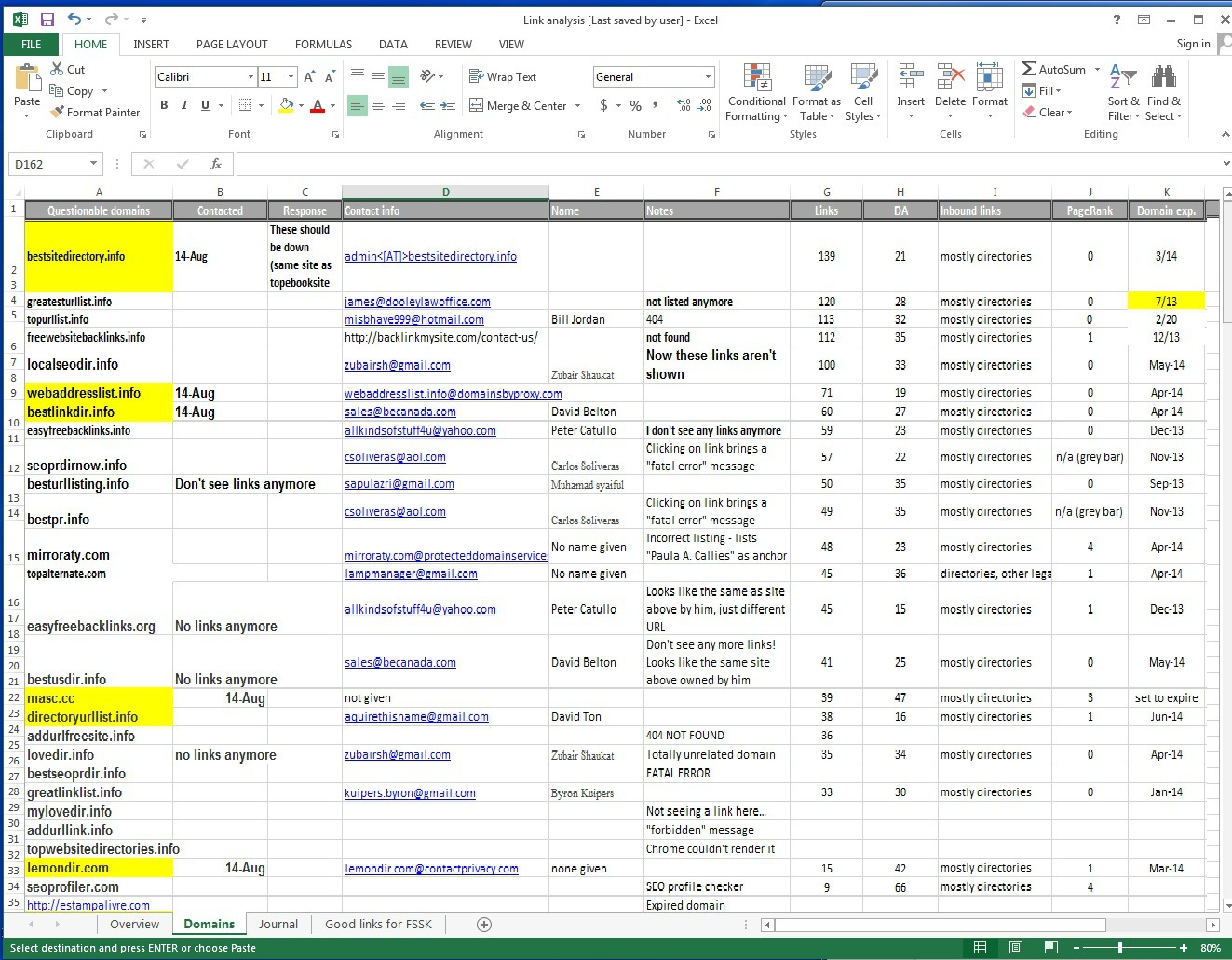
Subscribe to our newsletter!
We don't spam. You will only receive relevant and important tips for you and your business.
Unsubscribe anytime.
By Ryan Boog
Much has been discussed regarding Google’s disavow toot. The purpose of the disavow tool is to give webmasters the ability to clean up their own website with their own two hands - either from a manual penalty or from links that webmasters believe are affecting their rankings.
We took a stab at disavowal, and have been extremely disappointed to not only see negative results, but to see rankings worsen. Thus, we wanted to share our experience with you.

A bit of a backdrop: A client came to us after hiring a sub par SEO company and weren't pleased with the results. We took on the client and fixed the immediate problems right away, and the client had a successful campaign fairly quickly.
Our client once again enjoyed top rankings for all of the keywords and had a healthy, local campaign. One year ago, Google Analytics showed 85 percent of the traffic was organic, and our client ranked in the top five spots on Google for all the main keywords. In early 2013 the success continued. However, by spring, our client had dropped to the second, third, or fourth page for all of the keywords. When Penguin 2.0 hit, our client did not receive a manual penalty from Google but as spring progressed to summer, we were shocked to watch the traffic and rankings drop... and not recover.

All website traffic from October 2012 to October 2013. The gap in April was due to technical difficulties with analytics on multiple accounts.
Digging back into the work that was done by the previous SEO company, we knew we potentially had a decent sized battle in front of us regarding the shoddy work that had been done. There was a lot of bad links that pointed to the website and disavowing would be a large chore. We revisited the on-page optimization, sought more high-quality links, created cool content to share, and hiked up our social media efforts. When none of this helped, we suspected that we had to correct all of the issues caused by the previous SEO company.
Our client had still not received any manual notifications of unnatural linking in Webmaster Tools, but from some initial inventory of the link profile, we suspected that the quality of the links could be better. From there, we did some research on the disavow tool and decided to try it.
Pre-disavow, our client had: • Over 11,000 links pointing to the website
• A domain authority of 39
• An Alexa ranking of 21,872,853
• A PageRank of 3
I began a thorough link analysis of my client’s current domains in early August, and by August 19th I was ready to submit the disavow text file to Google.
Before disavowing, I had to choose which links to include in this file. Webmasters are strongly urged against carelessly disavowing links, and I didn’t want to disavow any high-quality ones. Obviously you don’t want to throw the baby out with the bathwater. In analyzing which domains to keep and which to get rid of, I followed a process similar to the one Chuck Price recommends in his article on Search Engine Watch.

If you can read the tiny print on this Excel spreadsheet of our client, you'll see how bad many of these domains are... like "easyfreebacklinks.org." Nope, don't want that one.
I went through my backlinks on Google Webmaster Tools and evaluated their quality, keeping track of the following information about each domain or URL on a spreadsheet:
• Domain/URL
• Number of links from this domain pointing to my client’s site
• Domain authority of the site
• PageRank of the site
• Inbound link quality
• Domain expiration date
• Notes/observations about the quality of the domain
Then I filtered out the worst domains. My first indicator of a poor quality domain was an obvious factor that I could see immediately by visiting the site: whether or not it was a link submission site or a site strictly intended for SEO companies to use for links. These are not user-friendly or in accordance with Google’s quality guidelines.
Next, I checked whether or not the site was relevant to my client’s business. Our client is a law firm, so the site had to be somehow relevant to law or legal professionals. This was rather common sense - i.e. I found some links on celebrity blogs or foreign news sites that had exact match anchor text pointing back to my client’s site. Even though these websites weren’t spammy, the comments with the links were, and they were obviously not following Google’s guidelines. So I kept strict guidelines pertaining to this.
Additionally, I marked all domains with low PageRank, spammy link profiles, soon-to-expire domains, and little real value to offer visitors that had no relevancy to the business.
Matt Cutts encourages webmasters to request link take-down before ever submitting a file to Google - apparently it’s important that you prove to Google that you’ve made an attempt on your own. So I created a new Gmail account and started rattling off link takedown requests to webmasters managing domains that linked the most to my client’s website, and to the worst links.
I kept track of my communication with the webmasters, including:
• Date of contact
• Response
• Contact information
• Name of webmaster
Within a few days, I’d gotten responses from webmasters saying they’d complied with my requests. That was encouraging! However, not everyone replied. Also, as a busy agency with limited hours, I simply didn’t have the time to contact each and every webmaster. So after giving webmasters the weekend and a few days to comply with my request, I submitted my disavow file.
My initial disavow request on August 19th contained 65 domains. I followed up with three additional domains on Sept. 3.

Organic traffic from Aug. 19 to September 2013.
Our report to our client at the end of August was dour. Organic search was half of what it had been in early 2013, and down to only 66 percent of total traffic. We described our link removal process and told the client to hang tight. Bless the client's heart. Mostly, rankings had dropped in the past month. There were no positive results to report yet. It was not a happy report.
Throughout early September, I waited to perform any additional SEO because I wanted to observe the effects of disavow on the site. However, as the weeks went on, my client’s rankings hovered out of sight in the search results. They did not go up. They remained the same, or dropped even lower.
By mid-September, I went on a slight rampage in order to feed Google new links to replace the old ones - creating new content for the site, creating cool content to share, social media sharing, etc. I ensured that the site optimization was totally on-point. New, high quality links were pointing back to the site through relevant channels. Still, everything seemed to move backwards.
By Sept. 30, my client’s domain authority had dropped from a 39 in August to a 35 - four whole points! That indicated that the lack of links was at work here.

Google advises to tread cautiously when using the disavow tool, saying it’s not meant for most webmasters. We understood that. We also knew that Google reserves the right to ignore your request to disavow. And results may be slow. Google Support states that “It may take some time for Google to process the information you’ve uploaded. In particular, this information will be incorporated into our index as we re-crawl the web and reprocess the pages that we see, which can take a number of weeks.”
Considering the above information, it’s been two months since I submitted the disavow request. I expected to see rankings improve. I know that my client had some low-quality links. I cleaned them up. Better links that were natural started to point back at the site. And I can tell that the disavow worked to some extent - because the links have decreased, and so have the rankings. However, now that I've cleaned up the link profile, I have not seen the rankings improve - only sink lower.
Google’s disavow tool really isn’t the solution to improve lost rankings. Even though the tool exists to help webmasters, I have read that it may hurt rather than help. Google has advised against using the tool if you don’t have a manual action. So even though my client’s links were of low quality and we felt justified using the tool, even more has to be done along with disavowing a portion of the bad backlinks.
Google still gives credit to bad backlinks. It is just fact. We had those bad links. When removed, we instantly saw drops across the board. Just putting two and two together, you can see that at least in the short term, Google hasn't 100% mastered the art of "what is a good backlink." This is not a call to get bad links -- that will eventually bury your site. This is a call to not panic super hard when there is a ton of bad backlinks. Just gently phase out the bad ones while garnering attention properly across the web.
Google’s disavow tool may help improve rankings, but it gets worse before it gets better. I’ve cleaned up my client’s link profile, but Google hasn’t boosted the rankings at all - just dropped them for having less links. In that case, I should assume that Disavow alone won’t do the trick to restore lost rankings. However, it may still be a necessary tool and a necessary action. That was the basis of our decision to use the tool.
My client’s competitors have stepped up their SEO. Despite cleaning up the link profile, my client is suffering in the search results because their competitors are beating them to the punch. In that case, I'm severely disappointed and upset, because I have looked at the link profiles of sites above the - and let me tell you, they are not all pretty. Some are simply old, outdated, and not user-friendly. Many are using poor SEO practices that are soon to be noticed by Google. In doing a competitor analysis, I noticed one attorney's site in particular that had a link that seemed legitimate, so I checked it, thinking it might be a good opportunity for my client. It wasn't. It was a site created by the attorney's own law firm that had no new services or information to offer visitors - it simply masqueraded as another sector of the law firm’s services. But all it did was link back to the original site. That is not the high-quality behavior that Matt Cutts is calling for.
My client’s SEO is somehow still not up to snuff. Perhaps despite all our efforts, maybe Google is confused or seeing something they don’t like. For example, the links we opted to keep from the old SEO company came from more relevant websites and passed a little value. But inspecting deeper, a lot of the links were exact match and spammy. There are many factors that we need to really focus on quickly to right the wrongs of the poor SEO past.
It's not a happy story, but it's what we've experienced. In the meantime, we’re focusing on earning higher-quality links back to the site to replace the links we lost, and hoping that as a few more months pass, we will see better rankings.
What do you think about this study? What results have you seen using the Disavow tool?